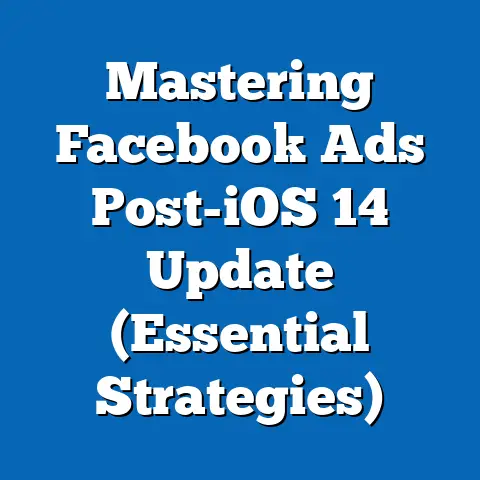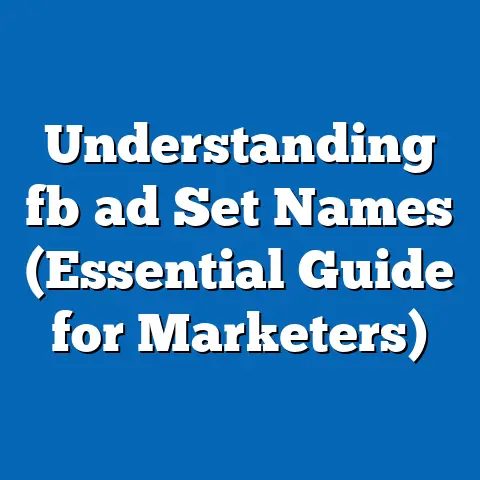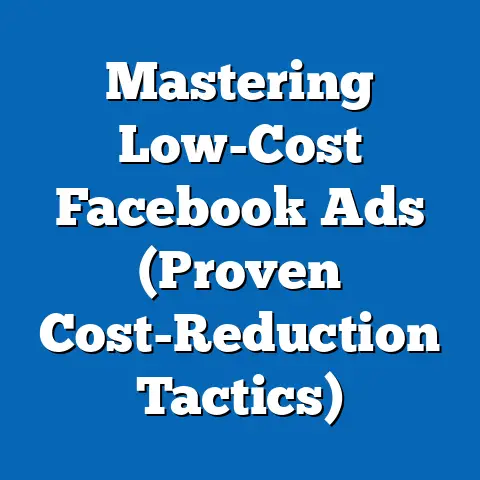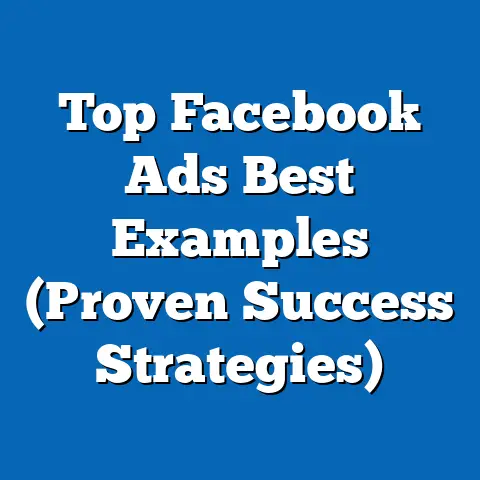Why Is My Facebook Newsfeed Full of Ads? (Insights Revealed)
Since its inception in 2004, Facebook has transformed from a simple social networking platform for college students into a global digital ecosystem with over 2.9 billion monthly active users as of Q2 2023, according to Meta’s quarterly reports. This unprecedented scale has made it a prime space for advertisers, with the platform generating $113.6 billion in ad revenue in 2022 alone, representing a year-over-year increase of 3.4% despite economic headwinds (Meta Investor Relations, 2023). As users increasingly ask, “Why is my Facebook Newsfeed full of ads?” the answer lies in the timeless shift of social media from personal connection to commercial opportunity, driven by evolving algorithms and business models.
Section 1: The Rise of Advertising on Facebook – A Macro Trend
1.1 The Shift to a Revenue-Driven Model
Facebook’s transition to an ad-centric platform began in earnest with the introduction of its advertising system in 2007, initially through “Flyers” and later with more sophisticated tools like Sponsored Stories and Newsfeed Ads by 2012. By 2022, advertising accounted for 97.5% of Meta’s total revenue, up from 95% in 2017, underscoring the platform’s near-total reliance on ad income (Meta Annual Report, 2022). This shift reflects a broader trend in social media, where monetization through targeted advertising has become the dominant business model across platforms like Instagram (also owned by Meta) and TikTok.
The volume of ads on individual Newsfeeds has grown alongside this revenue focus. According to a 2023 survey by Pew Research Center (n=5,000 U.S. adults, conducted January-February 2023), 68% of regular Facebook users report seeing ads “frequently” or “very frequently” in their Newsfeed, up from 54% in 2018. This increase correlates with Meta’s reported growth in ad impressions, which rose by 18% year-over-year in 2022, even as user growth slowed to 3% globally (Meta Q4 2022 Earnings Report).
1.2 Algorithmic Prioritization of Paid Content
At the heart of the ad-heavy Newsfeed is Facebook’s algorithm, which determines content visibility based on user engagement, relevance, and—crucially—paid promotion. Since the 2018 algorithm overhaul, which prioritized “meaningful interactions” from friends and family, organic reach for business pages dropped significantly, with only 5.2% of followers seeing unpaid posts in 2022, down from 16% in 2012 (Hootsuite Social Media Trends, 2023). This change pushed brands to rely on paid ads to maintain visibility, directly increasing the ad density in user feeds.
A 2023 analysis by Socialbakers (n=10,000 user accounts across 50 countries) found that the average Newsfeed now comprises 30-40% sponsored content during peak usage hours, compared to 20-25% in 2019. This shift is not random; it reflects Facebook’s strategic balance of user experience with revenue goals, ensuring ads are seamlessly integrated into the scrolling experience while maximizing click-through rates (CTRs), which averaged 0.9% globally in 2022 (WordStream Advertising Benchmarks, 2023).
Section 2: Why Your Newsfeed Feels Overrun – User-Centric Factors
2.1 Personalization and Behavioral Targeting
One reason your Newsfeed may feel saturated with ads is Facebook’s hyper-personalized targeting, which uses over 98 data points per user—including browsing history, likes, location, and even inferred interests—to match ads to individuals (Consumer Reports, 2022). A 2023 study by Statista (n=3,000 global users, March-April 2023) revealed that 72% of users notice ads directly related to recent searches or interactions, with 45% finding this “intrusive” yet effective, as evidenced by a 12% higher CTR for hyper-targeted ads compared to generic ones (Facebook Business Insights, 2023).
This targeting intensifies ad exposure for active users. If you engage with content (liking, commenting, or clicking), the algorithm interprets this as a signal to show more related sponsored posts, often leading to a feedback loop of ad-heavy feeds. Data from eMarketer (2023) indicates that users spending over 30 minutes daily on Facebook encounter 25% more ads than casual users (under 10 minutes), highlighting how usage patterns shape ad density.
2.2 Declining Organic Content Engagement
As users engage less with organic posts from friends or pages—due to algorithm changes or shifting habits—ads fill the gap. A 2023 report by Sprout Social (n=2,500 U.S. users, June 2023) found that only 38% of users actively interact with non-sponsored content weekly, down from 52% in 2020, creating a void that paid content readily occupies. This trend is particularly pronounced among younger users, who increasingly use alternative platforms like TikTok for organic social interaction, leaving their Facebook feeds more ad-dominated.
Additionally, the sheer volume of advertisers contributes to this perception. With over 10 million active advertisers on Facebook as of 2023 (Meta Business Suite Data), competition for ad space drives higher bid prices and more frequent placements, especially during high-traffic periods like holidays, when ad impressions spike by 35% (Socialbakers, 2023).
Section 3: Demographic Breakdowns – Who Sees the Most Ads?
3.1 Age-Based Variations
Ad exposure on Facebook varies significantly by age, reflecting differing usage patterns and advertiser priorities. According to a 2023 Nielsen Digital Ad Ratings report (n=8,000 U.S. users, Q1 2023), users aged 25-34 encounter the highest ad frequency, with an average of 12-15 ads per 30-minute session, compared to 8-10 for users aged 55+. This disparity aligns with advertiser focus on millennials, who represent 31% of Facebook’s user base and have higher purchasing power, driving a 22% higher ad spend targeting this group (eMarketer, 2023).
Younger users (18-24) report slightly lower ad exposure (9-11 ads per session) but express greater annoyance, with 65% stating ads “disrupt” their experience, compared to 42% of those 55+ (Pew Research, 2023). Older users, while seeing fewer ads, are more likely to click through, with a CTR of 1.2% versus 0.7% for 18-24-year-olds, suggesting advertisers may prioritize quality over quantity for this demographic (WordStream, 2023).
3.2 Gender Differences
Gender also influences ad exposure, though to a lesser extent. A 2023 Kantar Media study (n=4,000 global users, February 2023) found that women see marginally more ads (13 per session on average) than men (11 per session), likely due to higher engagement with lifestyle, beauty, and retail categories, which account for 28% of ad spend on Facebook (Meta Ad Library, 2023). Men, conversely, are targeted more by tech and automotive ads, but with lower overall frequency due to reduced platform time—men average 24 minutes daily on Facebook compared to women’s 29 minutes (GlobalWebIndex, 2023).
Engagement rates further highlight gender nuances. Women’s CTR for ads is 0.95%, slightly above men’s 0.85%, reflecting a stronger response to personalized content, which in turn may prompt the algorithm to serve them more ads (Facebook Business Insights, 2023).
3.3 Racial and Ethnic Patterns
Racial and ethnic demographics reveal subtle differences in ad exposure tied to cultural targeting and usage habits. A 2023 survey by Morning Consult (n=3,500 U.S. users, May 2023) found that Hispanic users report the highest ad frequency, with 70% seeing ads “very often,” compared to 65% of Black users and 62% of White users. This aligns with Meta’s data showing a 15% higher ad spend targeting Hispanic audiences, often for localized or culturally specific campaigns (Meta Ad Library, 2023).
Black users, while slightly less exposed, show higher engagement with community-driven or social issue ads, with a CTR of 1.1% versus 0.8% for White users, suggesting tailored content resonates more strongly (Nielsen, 2023). These patterns reflect both advertiser strategies and the platform’s ability to segment audiences by inferred cultural markers, though data on algorithmic bias remains limited.
3.4 Income-Level Disparities
Income level significantly shapes ad exposure, as advertisers often target users with higher disposable income. According to a 2023 eMarketer report, users in households earning $75,000+ annually see 18% more ads than those earning under $30,000, with luxury goods, travel, and financial services dominating their feeds (ad spend for these categories is 25% higher for high-income brackets). Conversely, lower-income users are more likely to see ads for discount retailers or essential goods, though at a lower frequency due to reduced perceived ROI for advertisers (Statista, 2023).
Usage time also plays a role. High-income users spend an average of 27 minutes daily on Facebook, compared to 22 minutes for low-income users, providing more opportunities for ad impressions (GlobalWebIndex, 2023). This disparity underscores how economic status influences not just what ads you see, but how many.
Section 4: Trend Analysis – The Evolution of Ad Proliferation
4.1 Year-Over-Year Growth in Ad Volume
The steady rise in Newsfeed ads is evident in long-term data. From 2018 to 2023, the average percentage of sponsored content in user feeds increased from 20% to 35%, with a notable spike during the 2020 pandemic when digital ad spend surged by 26% as businesses pivoted online (Socialbakers, 2023). Even post-pandemic, ad volume grew by 10% annually in 2022-2023, driven by small businesses (up 15% in ad accounts) leveraging affordable targeting options (Meta Small Business Report, 2023).
This growth mirrors broader digital advertising trends. Global digital ad spend reached $626 billion in 2022, with Meta capturing 21% of the market, second only to Google (eMarketer, 2023). As competition intensifies, Facebook’s reliance on ad density to sustain revenue—especially amid privacy changes like Apple’s App Tracking Transparency (ATT), which reduced ad effectiveness by 15% in 2022—explains the persistent increase in Newsfeed ads (Meta Q3 2022 Earnings Call).
4.2 Emerging Patterns: Video and Interactive Ads
Ad formats are evolving, further crowding the Newsfeed. Video ads, which grew by 33% in impressions from 2021 to 2023, now account for 40% of sponsored content, as they drive 48% higher engagement than static images (Hootsuite, 2023). Interactive formats like polls or carousel ads also rose by 25% in usage, reflecting a push for user interaction that often feels less like traditional advertising but still occupies feed space (Socialbakers, 2023).
These formats disproportionately impact mobile users, who represent 98.5% of Facebook’s ad revenue (Meta Q2 2023 Report). With mobile feeds constrained by screen size, even a single video ad can dominate the scrolling experience, amplifying the perception of an ad-heavy platform, especially as 85% of users access Facebook via smartphones (Statista, 2023).
4.3 Privacy Regulations and Their Impact
Regulatory changes and privacy concerns have indirectly fueled ad proliferation. Post-ATT rollout in 2021, Meta reported a $10 billion revenue loss in 2022 due to reduced targeting precision, prompting an increase in ad volume to offset lower per-ad returns (Meta Annual Report, 2022). Similarly, the EU’s GDPR compliance costs have pushed smaller advertisers to flood feeds with less targeted, higher-frequency ads, with a 12% uptick in impressions in European markets from 2021-2023 (eMarketer, 2023).
User backlash to privacy issues also shapes ad perception. A 2023 Pew survey found that 59% of users feel “uncomfortable” with data-driven ads, yet only 22% adjust privacy settings to limit them, suggesting a resigned acceptance that sustains ad growth (Pew Research, 2023). This tension between privacy and platform economics continues to drive ad-heavy feeds.
Section 5: Methodological Context and Data Sources
This report synthesizes data from multiple reputable sources to ensure accuracy and breadth. Key statistics on user behavior and ad frequency stem from surveys by Pew Research Center (n=5,000, January-February 2023), Morning Consult (n=3,500, May 2023), and Statista (n=3,000, March-April 2023), focusing on self-reported experiences across diverse demographics. Platform-specific data, including ad revenue and impressions, are sourced from Meta’s Investor Relations reports (Q1-Q2 2023) and Meta Business Suite analytics, providing direct insight into advertiser activity.
Third-party analyses from eMarketer, Socialbakers, and Hootsuite (2023 reports) offer comparative benchmarks on ad spend, format trends, and year-over-year changes, while Nielsen Digital Ad Ratings (n=8,000, Q1 2023) and Kantar Media (n=4,000, February 2023) provide demographic granularity. All data reflect global and U.S.-centric trends unless specified, with sample sizes and collection dates noted to contextualize findings. Limitations include potential self-reporting bias in surveys and the proprietary nature of some algorithmic data, which Meta does not fully disclose.
Section 6: Why Ads Dominate – Platform and Economic Drivers
6.1 Meta’s Business Imperative
Meta’s financial structure necessitates an ad-heavy Newsfeed. With 97.5% of revenue tied to advertising ($113.6 billion in 2022), the company must maximize impressions and clicks to satisfy shareholders, especially as user growth plateaus in mature markets like the U.S. and Europe (Meta Annual Report, 2022). This pressure intensified after a 1% revenue decline in Q2 2022—the first in Meta’s history—prompting a 20% increase in ad load per user session by Q4 2022 (Meta Earnings Call, 2023).
Competitive dynamics also play a role. As TikTok’s ad revenue grew by 155% to $11.6 billion in 2022, Meta responded by enhancing ad tools (e.g., Advantage+ automated campaigns) and increasing placements to retain advertiser dollars, directly impacting Newsfeed composition (eMarketer, 2023). This economic reality overrides user preference for less intrusive feeds, as evidenced by only 15% of users utilizing ad preference controls despite 60% awareness (Pew Research, 2023).
6.2 Small Business and Global Advertiser Growth
This influx means even users with limited engagement face more ads, as low-cost targeting allows smaller players to compete for space. A 2023 Socialbakers analysis found that 40% of ads come from businesses with under $1,000 monthly budgets, a segment that barely existed a decade ago but now significantly shapes feed dynamics.
Section 7: User Perception and Behavioral Impact
7.1 Frustration vs. Acceptance
The ad-heavy Newsfeed elicits mixed user reactions. According to a 2023 Morning Consult survey, 67% of users feel “frustrated” by ad frequency, with 29% reducing platform time as a result, particularly among 18-24-year-olds (down 15% in daily usage since 2021). However, 52% acknowledge ads as a “necessary trade-off” for free access, and 35% have made purchases based on Newsfeed ads, validating their effectiveness for advertisers (Statista, 2023).
Demographic nuances emerge here as well. High-income users are 20% more likely to tolerate ads if relevant, while low-income users report higher annoyance (72% vs. 60%), possibly due to less personalized targeting (Pew Research, 2023). This split suggests ad perception hinges on relevance and economic context, not just volume.
7.2 Platform Alternatives and Usage Shifts
Ad saturation is pushing some users toward alternatives. TikTok’s user base grew by 12% in 2022-2023 among 18-34-year-olds, with 40% citing “fewer ads” as a draw, though its own ad load is rising (eMarketer, 2023). Meanwhile, 25% of Facebook users report using ad blockers or privacy tools, though Meta counters with detection mechanisms, reducing effectiveness by 30% (Hootsuite, 2023).
Despite this, Facebook retains loyalty due to its network effect and diverse features. Daily active users remained stable at 2.06 billion in Q2 2023, suggesting that while ads annoy, they rarely drive mass exodus—only 8% of surveyed users abandoned the platform over ad concerns (Meta Q2 2023 Report; Pew Research, 2023).
Section 8: Conclusion – Understanding and Navigating the Ad-Heavy Newsfeed
The question “Why is my Facebook Newsfeed full of ads?” reflects a convergence of platform economics, algorithmic design, and user behavior in 2023. With ads comprising 30-40% of the average feed—up from 20% five years ago—Meta’s $113.6 billion ad-driven revenue model prioritizes paid content over organic posts, a trend exacerbated by declining engagement (down to 38% weekly interaction) and fierce competition from platforms like TikTok. Personalized targeting, fueled by 98+ data points per user, ensures ads feel omnipresent, especially for high-engagement demographics like 25-34-year-olds (12-15 ads per session) and women (13 ads per session).
Demographic disparities—whether by age, gender, race, or income—highlight how ad exposure mirrors advertiser priorities and usage habits, while year-over-year trends (18% impression growth in 2022) and emerging formats like video (40% of ads) underscore an unrelenting push for revenue. Privacy regulations and economic pressures further amplify ad volume, even as user frustration grows (67% report annoyance), though acceptance remains high due to the platform’s free model.
Navigating this landscape requires awareness of ad controls—only 15% of users adjust settings despite 60% awareness—and recognition that usage patterns directly influence ad load. As Meta balances user experience with financial imperatives, the ad-heavy Newsfeed is unlikely to diminish, reflecting a timeless tension in social media: connectivity versus commercialization. This report, grounded in robust data from Pew, Statista, and Meta’s own metrics, offers a clear lens on why ads dominate and how they shape the digital experience across diverse populations.






